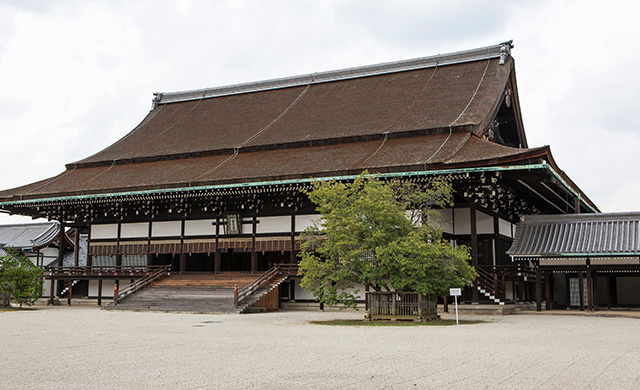Our hotel is surrounded by tourist attractions ranging from popular leisure spots to places known for their scenic beauty.
Make a plan that matches your mood and get the most out of your trip.

Nijo Castle (Nijo-jo)
541, Nijojo-cho, Nijo-dori, Horikawa, Nishi-iru, Nakagyo-ku, Kyoto
-
Tokugawa Ieyasu, the first shogun of the Tokugawa Shogunate, built Nijo Castle as his Kyoto lodging in 1603. The site is comprised mainly of the stunning Ninomaru Palace and Honmaru Palace, though the Honmaru Palace you see today is actually the old Katsura-no-miya Palace that was moved to the site at a later date. Nijo Castle is one of the Historic Monuments of Ancient Kyoto that has been designated by UNESCO as a World Heritage Site.

Shiunzan Chohoji Temple (Rokkakudo Temple)
Donomae-cho, Higashi-no-toin, Nishi-iru, Rokkaku-dori, Nakagyo-ku, Kyoto
-
This temple was founded by Prince Regent Shotoku (Shotoku Taishi) in 587 and is known these days as “Rokkaku-do (hexagonal hall),” due to the hexagonal shape of its main hall. It is part of both the Saigoku Kannon Pilgrimage and the Rakuyo Kannon Pilgrimage, and is famous for being the birthplace of Ikebana – the Japanese art of flower arrangement.

Heian Shrine (Heian Jingu)
Nishi Tenno-cho, Okazaki, Sakyo-ku, Kyoto
-
Heian Shrine was founded in 1895 to commemorate the 1100th anniversary of the former ancient Japanese capital Heian-Kyo, with former Emperor Kanmu as its main enshrined deity. The main hall is a reproduction of Chodo-in, the Emperor’s palace during the Heian period (794-1185). Heian Jingu Gaien, a strolling garden with ponds, surrounds the the shrine.

Kyoto Imperial Palace (Kyoto Gosho)
3, Kyoto Gyoen, Kamigyo-ku, Kyoto
-
This was the imperial palace where emperors resided as of the beginning of the Heian Period (794-1185), when Emperor Kanmu established the Heian-Kyo as the capital, up until the start of the Meiji period (1868-1912). The current structure was built in 1855 and recreates various architectural styles that date from the Heian Period and thereafter, evident on the Shishinden and Seiryoden.

Kitano Tenmangu Shrine
Bakuro-cho, Kamigyo-ku, Kyoto
-
Kitano Tenmangu was built in 947 to enshrine Sugawara no Michizane, a scholar and bureaucrat of the Heian Period. Known informally as “Kitano-no Tenjin-san” and loved by many, this shrine is famous for its beautiful plum trees in early spring and gorgeous colored leaves in fall. A festival is held in the shrine grounds on the 25th of every month, and with the many food stalls and shop stands the place positively bustles with visitors.

Kiyomizu-dera Temple
1-294, Kiyomizu, Higashiyama-ku, Kyoto
-
Kiyomizu-dera Temple is the head temple of Kita Hosso sect and known for its iconic wide stage. It is one of the Historic Monuments of Ancient Kyoto UNESCO World Heritage sites. The roof of the main hall, which is designated as a national treasure, is currently under renovation and is being refurbished with new design.
* This image is sourced from a database of pictures for free use.

Nanzen-ji Temple
Fukuchi-cho, Nanzenji, Sakyo-ku, Kyoto
-
Founded in 1291, Nanzen-ji temple is the headquarters for the Nanzen-ji branch of Rinzai Zen. Notable structures on the premises include the hojo (abbot’s quarters), which is designated a national treasure, and the Sanmon gate, recognized as an important cultural property. The hojo garden that is said to have been built by Kobori Enshu is also of note. Nanzen-ji is known as one of the best spots for viewing cherry blossoms in the spring and colored leaves in the fall.

Katsura Imperial Villa (Katsura Rikyu)
Katsura Misono, Nishikyo-ku, Kyoto
-
Intended as a villa for Prince Hachijo, the construction on Katsura Imperial Villa began in 1615 and was not completed until forty seven years later. Several buildings are scattered across the sprawling land and integrated with the exquisite strolling garden that justifies the villas reputation as a masterpiece of Japanese gardening.

Kyoto Tower
721-1, Higashi shiokoji-cho, Shichijo-sagaru, Karasuma-dori, Shimogyo-ku, Kyoto
-
Kyoto Tower is an iconic landmark that was designed to resemble a lighthouse shining over the city. This 131-meter-high tower is the tallest construction in Kyoto City, and its observatory – which is 100 meters from the ground – offers sweeping 360-degree panoramic views of the historic city surrounded by the Higashiyama mountain range.




